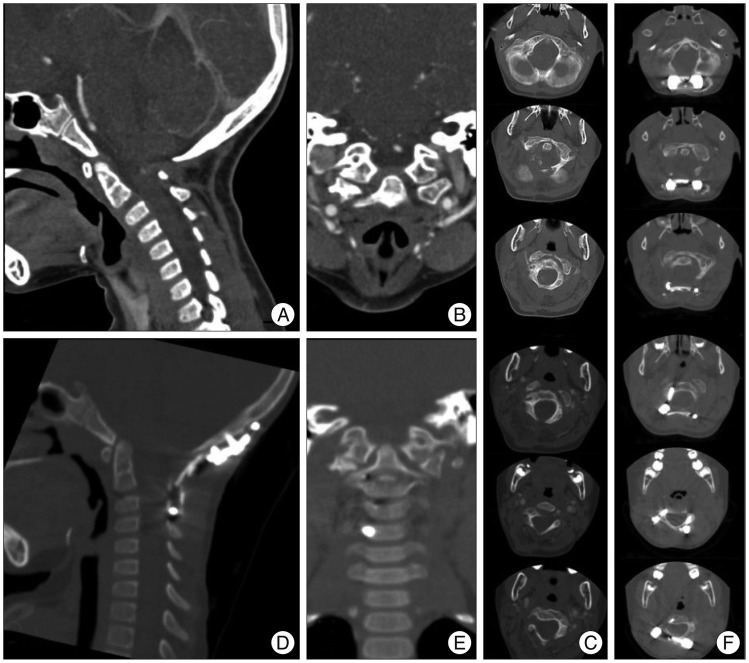J Korean Neurosurg Soc.
2014 May;55(5):284-288. 10.3340/jkns.2014.55.5.284.
A Morphologically Atypical Case of Atlantoaxial Rotatory Subluxation
- Affiliations
-
- 1Department of Neurosurgery, Nagoya University School of Medicine, Nagoya, Japan. umebayad@gmail.com
- KMID: 2018036
- DOI: http://doi.org/10.3340/jkns.2014.55.5.284
Abstract
- A rare case of atlantoaxial rotatory subluxation occurred after pediatric cervical spine surgery performed to remove a dumbbell-shaped meningioma at the level of the C1/C2 vertebrae. This case is classified as a post-surgical atlantoaxial rotatory subluxation, but has a very rare morphology that has not previously been reported. Although there are several reports about post-surgical atlantoaxial rotatory subluxation, an important point of this case is that it might be directly related to the spinal cord surgery in C1/C2 level. On day 6 after surgery, the patient presented with the Cock Robin position, and a computed tomography scan revealed a normal type of atlantoaxial rotatory subluxation. Manual reduction was performed followed by external fixation with a neck collar. About 7 months after the first surgery, the subluxation became severe, irreducible, and assumed an atypical form where the anterior tubercle of C1 migrated to a cranial position, and the posterior tubercle of C1 and the occipital bone leaned in a caudal direction. The pathogenic process suggested deformity of the occipital condyle and bilateral C2 superior facets with atlantooccipital subluxation. A second operation for reduction and fixation was performed, and the subluxation was stabilized by posterior fixation. We encountered an unusual case of a refractory subluxation that was associated with an atypical deformity of the upper spine. The case was successfully managed by posterior fixation.
Figure
Reference
-
1. Doshi J, Anari S, Zammit-Maempel I, Paleri V. Grisel syndrome : a delayed presentation in an asymptomatic patient. J Laryngol Otol. 2007; 121:800–802. PMID: 17295941.2. Fielding JW, Hawkins RJ. Atlanto-axial rotatory fixation (Fixed rotatory subluxation of the atlanto-axial joint). J Bone Joint Surg Am. 1977; 59:37–44. PMID: 833172.
Article3. Hamai S, Harimaya K, Maeda T, Hosokawa A, Shida J, Iwamoto Y. Traumatic atlanto-occipital dislocation with atlantoaxial subluxation. Spine (Phila Pa 1976). 2006; 31:E421–E424. PMID: 16741443.
Article4. Ishii K, Chiba K, Maruiwa H, Nakamura M, Matsumoto M, Toyama Y. Pathognomonic radiological signs for predicting prognosis in patients with chronic atlantoaxial rotatory fixation. J Neurosurg Spine. 2006; 5:385–391. PMID: 17120886.
Article5. Ishii K, Toyama Y, Nakamura M, Chiba K, Matsumoto M. Management of chronic atlantoaxial rotatory fixation. Spine (Phila Pa 1976). 2012; 37:E278–E285. PMID: 22281477.
Article6. Pang D. Atlantoaxial rotatory fixation. Neurosurgery. 2010; 66(3 Suppl):161–183. PMID: 20173520.
Article7. Pilge H, Prodinger PM, Bürklein D, Holzapfel BM, Lauen J. Nontraumatic subluxation of the atlanto-axial joint as rare form of acquired torticollis : diagnosis and clinical features of the Grisel's syndrome. Spine (Phila Pa 1976). 2011; 36:E747–E751. PMID: 21178843.8. Subach BR, McLaughlin MR, Albright AL, Pollack IF. Current management of pediatric atlantoaxial rotatory subluxation. Spine (Phila Pa 1976). 1998; 23:2174–2179. PMID: 9802157.
Article9. Wilson BC, Jarvis BL, Haydon RC 3rd. Nontraumatic subluxation of the atlantoaxial joint : Grisel's syndrome. Ann Otol Rhinol Laryngol. 1987; 96:705–708. PMID: 3688763.
Article10. Wilson MJ, Michele AA, Jacobson EW. Spontaneous dislocation of the atlanto-axial articulation, including a report of a case with quadriplegia. J Bone Joint Surg Am. 1940; 22:698–707.
- Full Text Links
- Actions
-
Cited
- CITED
-
- Close
- Share
- Similar articles
-
- Combined Atlantoaxial Rotatory Fixation and Unilateral Counter Occipitoatlantal Subluxation after Minor Trauma
- Torticollis and Atlantoaxial Rotatory Subluxation after Chiropractic Therapy
- A Spontaneous Atlantoaxial Subluxation: A case repor
- Role of the O-arm and Computer-assisted Navigation of Safe Screw Fixation in Children with Traumatic Rotatory Atlantoaxial Subluxation
- The Treatment of Traumatic Atlantoaxial Rotatory Subluxation (Fielding Type I) and the Correlation between the Clinical Progress and Radiological Reduction Parameter






